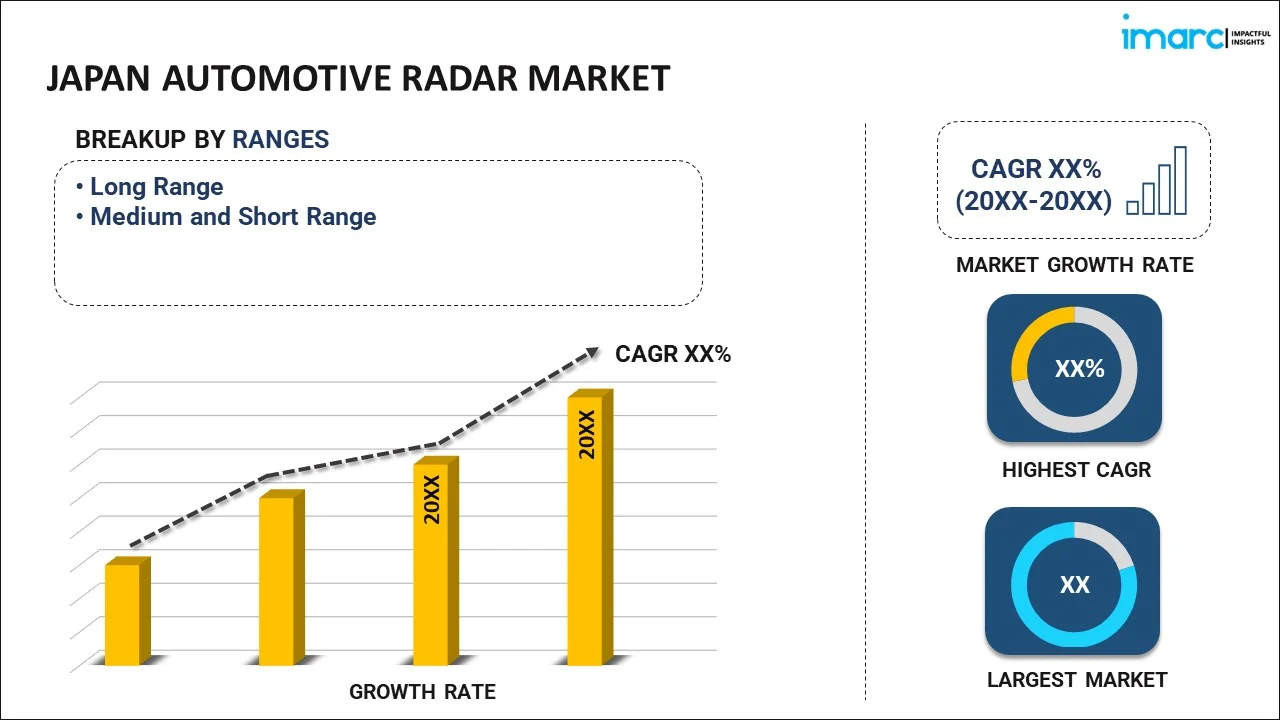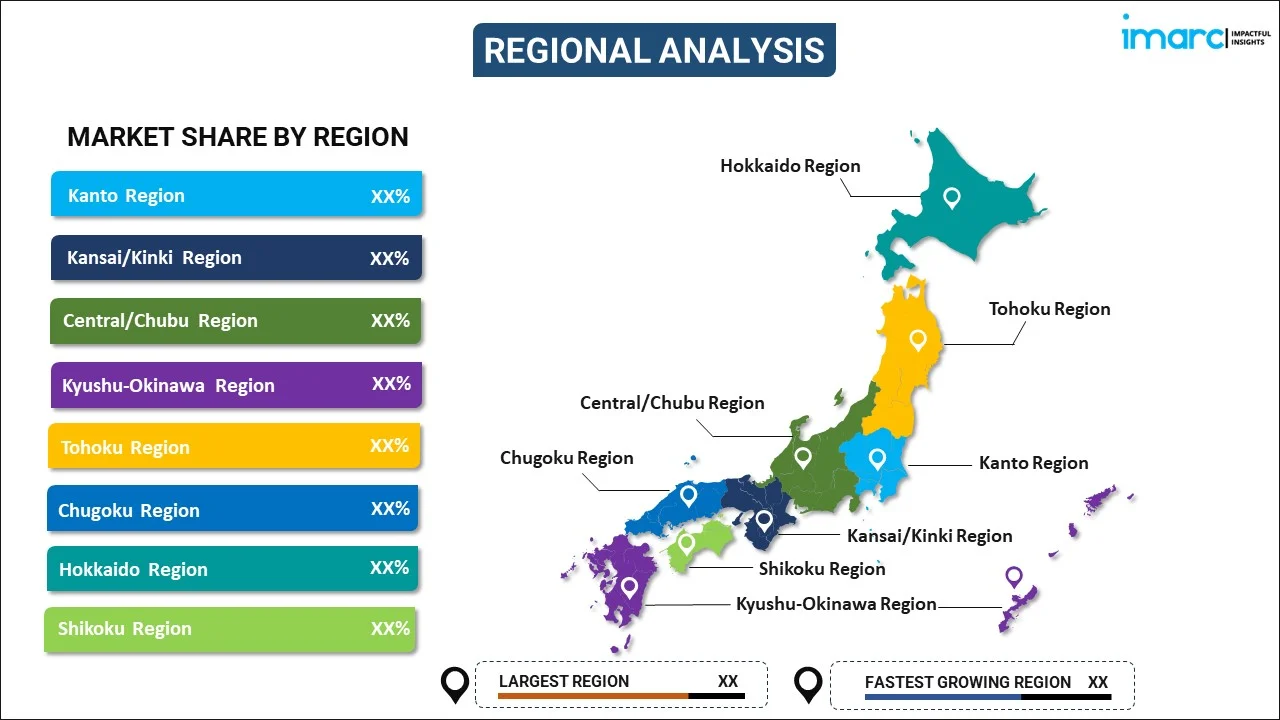
Japan Automotive Radar Market Report by Range (Long Range, Medium and Short Range), Vehicle Type (Passenger Cars, Commercial Vehicles), Application (Adaptive Cruise Control (ACC), Autonomous Emergency Braking (AEB), Blind Spot Detection (BSD), Forward Collision Warning (FCW), Intelligent Park Assist, and Others), and Region 2025-2033
Market Overview:
Japan automotive radar market size reached USD 389.2 Million in 2024. Looking forward, IMARC Group expects the market to reach USD 902.1 Million by 2033, exhibiting a growth rate (CAGR) of 9.8% during 2025-2033. The increasing awareness of the benefits of advanced driver assistance systems, along with the rising demand for vehicles equipped with radar-based technologies that enhance driver safety, is driving the market.
|
Report Attribute
|
Key Statistics
|
|---|---|
|
Base Year
|
2024 |
|
Forecast Years
|
2025-2033
|
|
Historical Years
|
2019-2024
|
| Market Size in 2024 | USD 389.2 Million |
| Market Forecast in 2033 | USD 902.1 Million |
| Market Growth Rate (2025-2033) | 9.8% |
Automotive radar is a technology used in vehicles to enhance safety and driving assistance systems. It operates by emitting radio waves and analyzing their reflections to detect nearby objects and their movements. This enables features like adaptive cruise control, blind spot monitoring, and collision avoidance. There are two primary types of automotive radar: long-range and short-range. Long-range radar helps vehicles maintain safe distances from other vehicles on highways, while short-range radar assists in parking and low-speed maneuvers. The radar system consists of a radar sensor, which transmits and receives signals, and a control unit that processes the data. When an object is detected, the system can provide visual or auditory alerts to the driver or even intervene by adjusting the vehicle's speed or steering to prevent a collision. Overall, automotive radar plays a crucial role in advancing vehicle safety by providing drivers with additional information and assistance, reducing the risk of accidents, and contributing to the development of autonomous driving technologies.
Japan Automotive Radar Market Trends:
The automotive radar market in Japan is experiencing robust growth due to several key drivers. Firstly, the increasing emphasis on safety in the automotive industry has propelled the demand for radar technology. Moreover, stringent government regulations mandating the incorporation of advanced driver assistance systems (ADAS) in vehicles have provided a significant impetus. Additionally, the rising consumer awareness regarding the benefits of radar-based features such as collision avoidance and adaptive cruise control has fueled market expansion. Furthermore, the growing trend towards autonomous vehicles is a pivotal driver, as radar systems play a crucial role in enabling vehicles to perceive and navigate their surroundings. Simultaneously, the continuous advancements in radar technology, including higher resolution and improved range, are encouraging automakers to integrate radar sensors into their vehicles. Moreover, the increasing consumer preference for premium and luxury vehicles, which often come equipped with sophisticated radar systems, is augmenting market growth. Lastly, the escalating utilization of electric vehicles (EV), since manufacturers prioritize radar technology to enhance safety and enable autonomous driving features in EVs, is expected to drive the automotive radar market in Japan during the forecast period.
Japan Automotive Radar Market Segmentation:
IMARC Group provides an analysis of the key trends in each segment of the market, along with forecasts at the country level for 2025-2033. Our report has categorized the market based on range, vehicle type, and application.
Range Insights:

- Long Range
- Medium and Short Range
The report has provided a detailed breakup and analysis of the market based on the range. This includes long range and medium and short range.
Vehicle Type Insights:
- Passenger Cars
- Commercial Vehicles
A detailed breakup and analysis of the market based on the vehicle type have also been provided in the report. This includes passenger cars and commercial vehicles.
Application Insights:
- Adaptive Cruise Control (ACC)
- Autonomous Emergency Braking (AEB)
- Blind Spot Detection (BSD)
- Forward Collision Warning (FCW)
- Intelligent Park Assist
- Others
The report has provided a detailed breakup and analysis of the market based on the application. This includes adaptive cruise control (ACC), autonomous emergency braking (AEB), blind spot detection (BSD), forward collision warning (FCW), intelligent park assist, and others.
Regional Insights:

- Kanto Region
- Kansai/Kinki Region
- Central/ Chubu Region
- Kyushu-Okinawa Region
- Tohoku Region
- Chugoku Region
- Hokkaido Region
- Shikoku Region
The report has also provided a comprehensive analysis of all the major regional markets, which include Kanto Region, Kansai/Kinki Region, Central/ Chubu Region, Kyushu-Okinawa Region, Tohoku Region, Chugoku Region, Hokkaido Region, and Shikoku Region.
Competitive Landscape:
The market research report has also provided a comprehensive analysis of the competitive landscape. Competitive analysis such as market structure, key player positioning, top winning strategies, competitive dashboard, and company evaluation quadrant has been covered in the report. Also, detailed profiles of all major companies have been provided. Some of the key players include:
- Aptiv PLC
- Continental AG
- Infineon Technologies AG
- Murata Manufacturing Co. Ltd.
- ROHM Co. Ltd.
(Please note that this is only a partial list of the key players, and the complete list is provided in the report.)
Japan Automotive Radar Market Report Coverage:
| Report Features | Details |
|---|---|
| Base Year of the Analysis | 2024 |
| Historical Period | 2019-2024 |
| Forecast Period | 2025-2033 |
| Units | Million USD |
| Scope of the Report | Exploration of Historical Trends and Market Outlook, Industry Catalysts and Challenges, Segment-Wise Historical and Future Market Assessment:
|
| Ranges Covered | Long Range, Medium and Short Range |
| Vehicle Types Covered | Passenger Cars, Commercial Vehicles |
| Applications Covered | Adaptive Cruise Control (ACC), Autonomous Emergency Braking (AEB), Blind Spot Detection (BSD), Forward Collision Warning (FCW), Intelligent Park Assist, Others |
| Regions Covered | Kanto Region, Kansai/Kinki Region, Central/ Chubu Region, Kyushu-Okinawa Region, Tohoku Region, Chugoku Region, Hokkaido Region, Shikoku Region |
| Companies Covered | Aptiv PLC, Continental AG, Infineon Technologies AG, Murata Manufacturing Co. Ltd., ROHM Co. Ltd., etc. |
| Customization Scope | 10% Free Customization |
| Post-Sale Analyst Support | 10-12 Weeks |
| Delivery Format | PDF and Excel through Email (We can also provide the editable version of the report in PPT/Word format on special request) |
Key Questions Answered in This Report:
- How has the Japan automotive radar market performed so far and how will it perform in the coming years?
- What has been the impact of COVID-19 on the Japan automotive radar market?
- What is the breakup of the Japan automotive radar market on the basis of range?
- What is the breakup of the Japan automotive radar market on the basis of vehicle type?
- What is the breakup of the Japan automotive radar market on the basis of application?
- What are the various stages in the value chain of the Japan automotive radar market?
- What are the key driving factors and challenges in the Japan automotive radar?
- What is the structure of the Japan automotive radar market and who are the key players?
- What is the degree of competition in the Japan automotive radar market?
Key Benefits for Stakeholders:
- IMARC’s industry report offers a comprehensive quantitative analysis of various market segments, historical and current market trends, market forecasts, and dynamics of the Japan automotive radar market from 2019-2033.
- The research report provides the latest information on the market drivers, challenges, and opportunities in the Japan automotive radar market.
- Porter's five forces analysis assist stakeholders in assessing the impact of new entrants, competitive rivalry, supplier power, buyer power, and the threat of substitution. It helps stakeholders to analyze the level of competition within the Japan automotive radar industry and its attractiveness.
- Competitive landscape allows stakeholders to understand their competitive environment and provides an insight into the current positions of key players in the market.
Need more help?
- Speak to our experienced analysts for insights on the current market scenarios.
- Include additional segments and countries to customize the report as per your requirement.
- Gain an unparalleled competitive advantage in your domain by understanding how to utilize the report and positively impacting your operations and revenue.
- For further assistance, please connect with our analysts.
 Inquire Before Buying
Inquire Before Buying
 Speak to an Analyst
Speak to an Analyst
 Request Brochure
Request Brochure
 Request Customization
Request Customization




.webp)




.webp)












